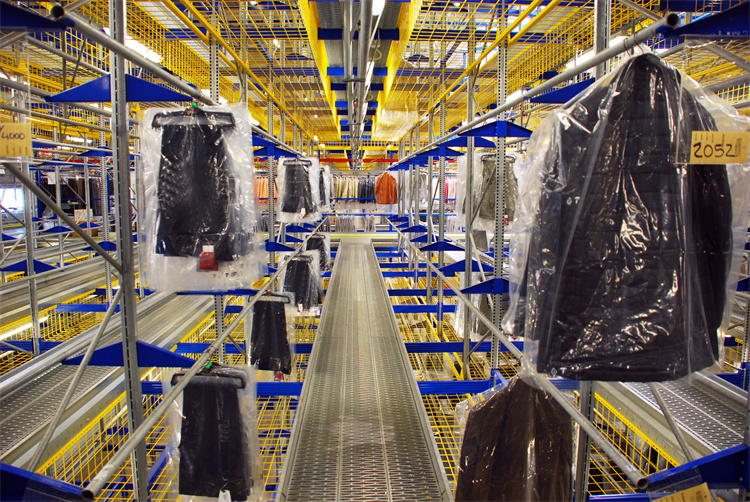Mastering Warehouse Efficiency with WMS

Warehouse efficiency is crucial for maintaining smooth operations and meeting customer demands. You can achieve this by implementing a Warehouse Management System (WMS). This powerful tool optimizes inventory management, reduces manual errors, and enhances order fulfillment speed. By automating key processes like order picking, packing, and shipping, WMS significantly boosts productivity. Real-time data on inventory levels and order status allows you to respond swiftly to changes, ensuring operational efficiency. Embracing WMS not only streamlines your warehouse operations but also contributes to cost savings and improved customer satisfaction.
Understanding Warehouse Management Systems (WMS)
Definition and Purpose of WMS
A Warehouse Management System (WMS) is a software application designed to enhance warehouse operations. You can automate many manual tasks like data entry and product tracking with a WMS. This automation saves time and reduces errors, allowing you to optimize workflows such as picking and packing. The primary objective of a WMS is to assist warehouse managers in improving efficiency and productivity. By implementing a WMS, you can meet customer demands and maintain a competitive edge in the market.
Key Features of WMS
Real-time Inventory Tracking: A WMS provides real-time data on inventory levels, order status, and worker productivity. This visibility helps you respond swiftly to changes in demand and operational challenges.
Order Management: You can configure picking strategies like wave picking or batch picking to increase efficiency. The system generates pick lists based on order priorities, ensuring timely and accurate order processing.
Automation: Automating key processes such as order picking, packing, and shipping enhances operational efficiency. Automated packing instructions ensure items are packed correctly, reducing the chances of damage during transit.
Benefits of Implementing WMS
Implementing a WMS offers numerous benefits. You can expect improved order fulfillment during the picking and packing process. The system helps verify items during packing to confirm order accuracy, reducing errors and improving customer satisfaction. Additionally, a WMS optimizes product placement within available warehouse space, minimizing waste and avoiding the need for additional warehouse expansion. By streamlining orders from online ecommerce channels, a WMS ensures faster, more accurate fulfillment operations, especially during peak seasons.
Types of WMS
Understanding the types of WMS available can help you choose the right system for your warehouse needs.
Standalone WMS
A Standalone WMS operates independently and focuses solely on warehouse management functions. It is ideal for businesses that require a dedicated system for managing warehouse operations without integrating with other enterprise systems. This type of WMS offers robust features for inventory and order management, making it suitable for small to medium-sized warehouses.
Integrated WMS
An Integrated WMS connects with other enterprise software, providing a unified view of warehouse activities. This integration allows for seamless data exchange between the WMS and other business systems, enhancing operational insights and improving overall warehouse performance. An integrated WMS is beneficial for larger organizations that require comprehensive supply chain management solutions.
Key Components of WMS
Inventory Management
Efficient inventory management forms the backbone of any successful warehouse operation. A Warehouse Management System (WMS) plays a pivotal role in this aspect by providing tools that enhance accuracy and efficiency.
Real-time Inventory Tracking
With real-time inventory tracking, you gain immediate visibility into your stock levels. This feature allows you to monitor inventory movements as they happen. You can quickly identify discrepancies and address them before they escalate into larger issues. Real-time data ensures that you always know what is available, reducing the risk of stockouts or overstocking. This capability not only improves operational efficiency but also enhances customer satisfaction by ensuring that products are available when needed.
Stock Replenishment
Stock replenishment becomes a streamlined process with a WMS. The system analyzes inventory levels and automatically triggers replenishment orders when stock falls below a predefined threshold. This proactive approach minimizes the chances of running out of stock and ensures that your warehouse operates smoothly. By automating replenishment, you reduce manual intervention, which decreases errors and saves time. This efficiency translates into cost savings and improved service levels.
Order Management
Order management is another critical component where a WMS can significantly enhance efficiency. By optimizing order processing and shipping, you can meet customer demands promptly and accurately.
Order Processing
Order processing involves several steps, from receiving orders to picking and packing items. A WMS simplifies this process by generating picking lists that guide your team in selecting items efficiently. You can implement various picking methods, such as batch picking, wave picking, or zone picking, to reduce travel time and improve accuracy. These techniques ensure that orders are processed quickly and correctly, enhancing overall productivity.
Shipping and Receiving
Shipping and receiving are integral parts of warehouse operations. A WMS streamlines these processes by providing detailed instructions and tracking capabilities. You can monitor shipments in real-time, ensuring that orders are dispatched on time and reach their destinations without delay. The system also facilitates efficient receiving by verifying incoming shipments against purchase orders. This verification reduces errors and ensures that your inventory records remain accurate.
By leveraging the key components of a Warehouse Management System, you can transform your warehouse operations. Real-time inventory tracking, automated stock replenishment, efficient order processing, and streamlined shipping and receiving all contribute to a more efficient and responsive warehouse environment.
Implementing WMS for Efficiency

Implementing a Warehouse Management System (WMS) can transform your warehouse operations, but it requires careful planning and execution. Here’s a guide to help you navigate the process effectively.
Steps to Implement WMS
Needs Assessment
Begin by assessing your warehouse needs. Identify the specific challenges you face, such as inventory inaccuracies or slow order processing. Understanding these issues will help you determine the features you need in a WMS. Consider factors like warehouse size, product types, and order volume. This assessment ensures that you select a system that aligns with your operational goals.
System Selection
Once you understand your needs, move on to selecting the right WMS. Evaluate different systems based on their features, scalability, and integration capabilities. Look for a solution that offers real-time inventory tracking, automated order processing, and seamless integration with existing business systems. A well-chosen WMS will enhance your warehouse efficiency and support future growth.
Challenges and Solutions
Common Implementation Challenges
Implementing a WMS comes with its own set of challenges. You might encounter resistance from staff who are accustomed to existing processes. Data migration can also pose difficulties, especially if your current data is disorganized. Additionally, integrating the WMS with other systems may require technical expertise.
Strategies for Overcoming Challenges
To overcome these challenges, start by involving your team early in the process. Provide training sessions to familiarize them with the new system. This approach reduces resistance and ensures a smoother transition. For data migration, clean and organize your data before transferring it to the WMS. This step minimizes errors and ensures accurate inventory records.
Integration challenges can be addressed by working closely with your IT team or hiring external experts. They can ensure that the WMS integrates seamlessly with your existing systems, providing a unified view of your operations.
Case Study: Nature’s Best successfully implemented a WMS by conducting thorough needs assessments and involving their team in the process. They overcame data migration challenges by cleaning their data beforehand, resulting in optimized warehouse operations.
By following these steps and addressing potential challenges, you can implement a WMS that significantly enhances your warehouse efficiency. This strategic approach not only improves operational performance but also positions your business for long-term success.
Measuring the Impact of WMS
Evaluating the effectiveness of a Warehouse Management System (WMS) involves analyzing specific metrics that reflect its impact on your operations. By focusing on key performance indicators (KPIs), you can gain insights into how well the system enhances your warehouse efficiency.
Key Performance Indicators (KPIs)
Inventory Accuracy
Inventory accuracy is crucial for maintaining smooth warehouse operations. A WMS provides real-time tracking, which helps you maintain precise inventory records. This accuracy reduces discrepancies between physical stock and recorded data. You can quickly identify and rectify errors, ensuring that your inventory levels reflect actual stock. Accurate inventory management minimizes stockouts and overstock situations, leading to better customer satisfaction and cost savings.
Order Fulfillment Speed
Order fulfillment speed is another critical KPI. A WMS optimizes order processing by generating efficient picking lists and automating packing instructions. These features streamline the picking and packing process, reducing the time it takes to fulfill orders. Faster order processing means you can meet customer demands promptly, enhancing your reputation and increasing customer loyalty. By monitoring this KPI, you can identify bottlenecks and implement strategies to improve order fulfillment speed.
Case Studies and Examples
Successful WMS Implementations
Many businesses have successfully implemented WMS solutions to enhance their warehouse operations. For instance, companies have reported significant improvements in inventory accuracy and order fulfillment speed after adopting a WMS. These systems automatically track and report on KPIs such as space utilization and storage turnover, providing valuable insights into warehouse performance. By leveraging these insights, businesses can optimize task allocation among workers and address productivity gaps.
Lessons Learned
Implementing a WMS offers valuable lessons for improving warehouse efficiency. One key takeaway is the importance of involving your team in the implementation process. Training and onboarding staff ensure that everyone is proficient in using the system, maximizing its benefits. Additionally, integrating the WMS with existing business systems enhances operational insights, leading to better decision-making. By learning from successful implementations, you can avoid common pitfalls and achieve optimal results.
Future Trends in WMS

Warehouse Management Systems (WMS) continue to evolve, driven by technological advancements and changing warehouse needs. These trends promise to enhance efficiency, productivity, and flexibility in warehouse operations.
Technological Advancements
AI and Machine Learning in WMS
Artificial Intelligence (AI) and Machine Learning (ML) are transforming how warehouses operate. You can use AI to improve inventory management by predicting demand more accurately. This technology enables data-driven decision-making, allowing you to optimize stock levels and reduce waste. AI-driven insights help you respond swiftly to changes in demand, ensuring that your warehouse remains efficient and competitive.
IoT Integration
The Internet of Things (IoT) is another game-changer for WMS. IoT devices provide real-time data on inventory levels, order status, and worker productivity. This connectivity allows you to monitor warehouse operations closely and make informed decisions. By integrating IoT, you can prevent stockouts, reduce excess inventory, and improve order processing times. This real-time visibility enhances customer satisfaction and operational efficiency.
Evolving Warehouse Needs
Adapting to E-commerce Growth
The rise of e-commerce has reshaped warehouse operations. You need to adapt to this growth by implementing flexible and scalable WMS solutions. Modern WMS systems offer adaptability and functionality to manage volatile market conditions. By investing in a robust WMS, you can address logistical challenges and meet the demands of online retail. This adaptability ensures that your warehouse can handle increased order volumes and maintain high service levels.
Sustainability and Green Practices
Sustainability is becoming a priority in warehouse management. You can incorporate eco-friendly practices into your operations by tracking carbon footprints and optimizing energy use. WMS technology supports these initiatives by providing insights into energy consumption and waste reduction. By focusing on sustainability, you not only contribute to environmental conservation but also enhance your brand's reputation. Green practices can lead to cost savings and improved customer loyalty.
JUSDA's Role in Enhancing Warehouse Efficiency
JUSDA's Comprehensive WMS Solutions
JUSDA offers comprehensive solutions that enhance warehouse efficiency. You can benefit from their robust Warehouse Management System (WMS) platforms, which manage tasks like order picking, packing, shipping, and receiving seamlessly. These platforms ensure that your operations run smoothly and efficiently.
Integration with JusLink Intelligent Supply Chain
JUSDA's WMS integrates with the JusLink Intelligent Supply Chain, providing a unified view of your logistics operations. This integration allows you to monitor inventory levels in real-time and make informed decisions. You can optimize stock levels and prevent shortages or overstock situations. The seamless connection with mainstream e-commerce platforms' EDI systems further enhances your ability to manage orders efficiently.
Industry-Specific Solutions
JUSDA tailors its warehousing solutions to meet the specific needs of various industries. Whether you deal with high-value goods requiring specialized storage or hazardous chemicals needing strict safety measures, JUSDA provides customized solutions. Their state-of-the-art temperature-controlled warehouses ensure that your products remain in optimal condition. By offering industry-specific solutions, JUSDA helps you maintain reliability and quality in your operations.
Case Studies of JUSDA's WMS Implementations
JUSDA's WMS implementations have transformed warehouse operations across different industries. You can learn from their success stories and apply similar strategies to enhance your own operations.
Success Stories in Various Industries
In the home appliance sector, JUSDA excels in assembly and delivery, ensuring timely delivery of goods. Their efficient inbound and outbound operations have set a benchmark for reliability. By leveraging JUSDA's warehousing solutions, businesses have achieved significant improvements in productivity and customer satisfaction. These success stories demonstrate the effectiveness of JUSDA's WMS in optimizing workflows and maximizing storage capacity.
Innovations and Future Directions
JUSDA continues to innovate by introducing automation and robotics for repetitive tasks. This transformation enhances productivity and reduces manual errors. You can expect JUSDA to lead the way in adopting new technologies that further streamline warehouse operations. Their commitment to innovation ensures that you stay ahead in the competitive logistics landscape.
By choosing JUSDA's comprehensive WMS solutions, you can enhance your warehouse efficiency and achieve operational excellence. Their industry-specific solutions and innovative approaches position you for long-term success.

JUSDA Solutions
To provide you with professional solutions and quotations.
Warehouse Management Systems (WMS) significantly enhance warehouse efficiency. They streamline operations, reduce errors, and improve customer satisfaction. As technology advances, WMS will continue to evolve, offering even more benefits. You should consider implementing a WMS to boost your operations. Real-world successes, like Averitt's 60-hour daily savings, highlight the transformative potential of WMS. JUSDA remains committed to innovation and efficiency, providing cutting-edge solutions tailored to your needs. By embracing these systems, you position your warehouse for future success and sustainability.
See Also
Boosting Efficiency: Robotics Revolutionizing Warehouse Operations
Maximizing Productivity: Understanding Robotic Automation in Warehouses
The Importance of Warehouse Automation for Business Success
Automated Tomorrow: Benefits of High-Tech Manufacturing Warehouses
Revealing the Power: JUSDA's Latest Innovations in Warehousing
